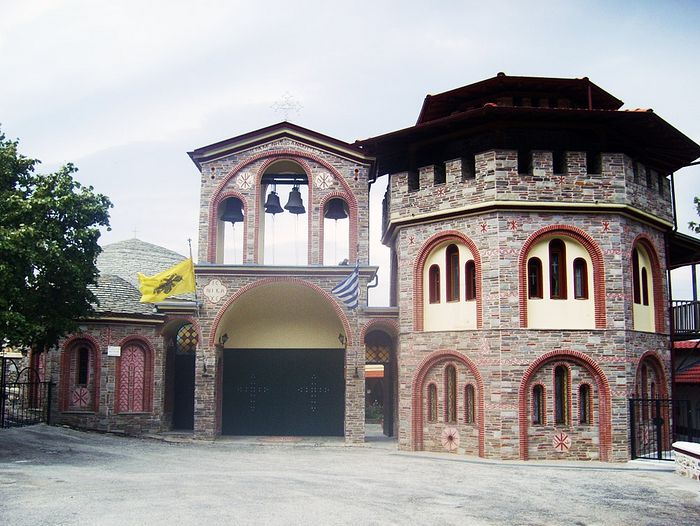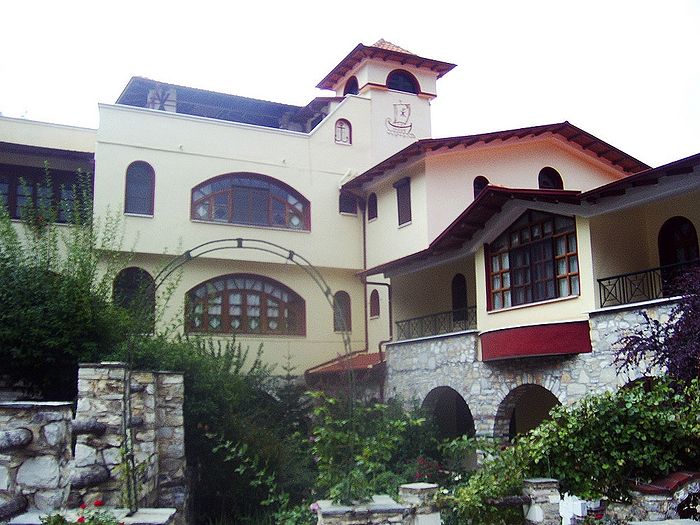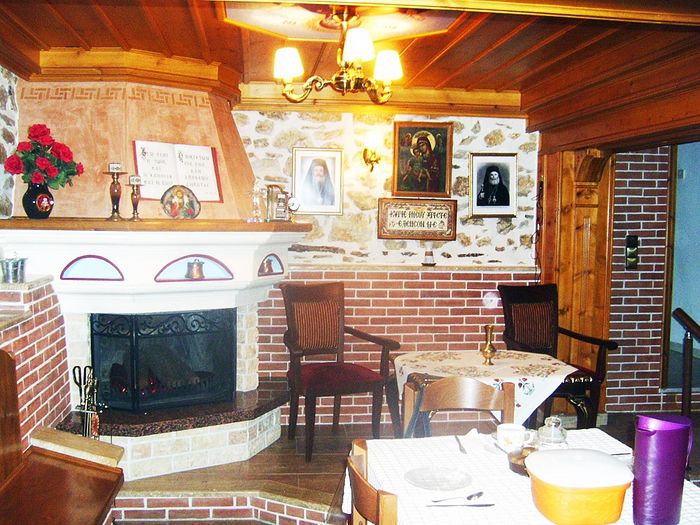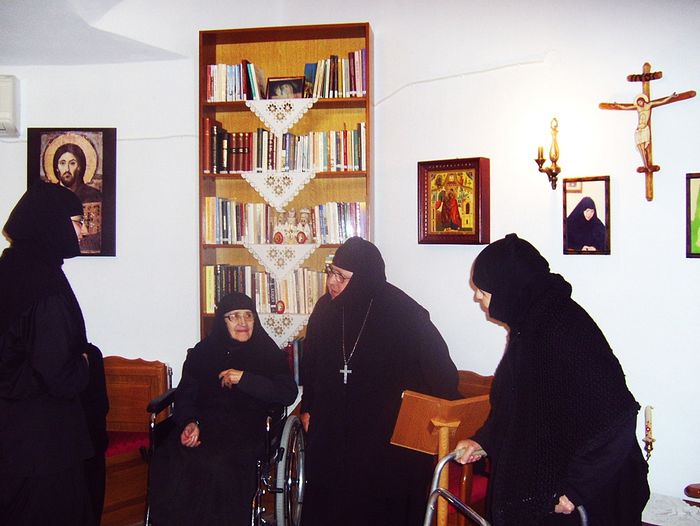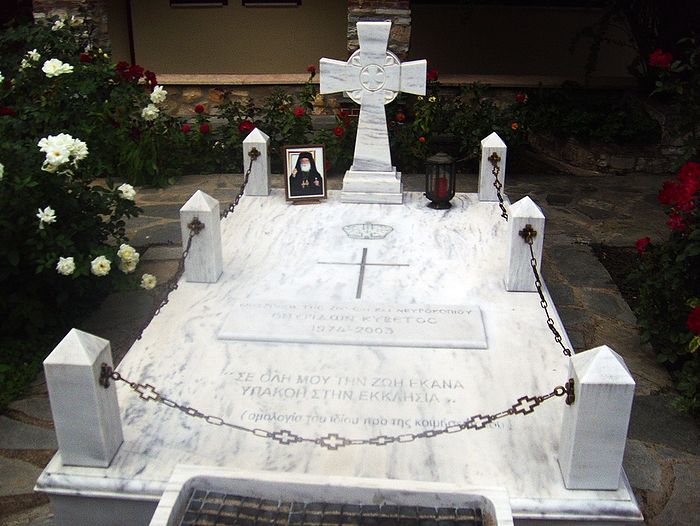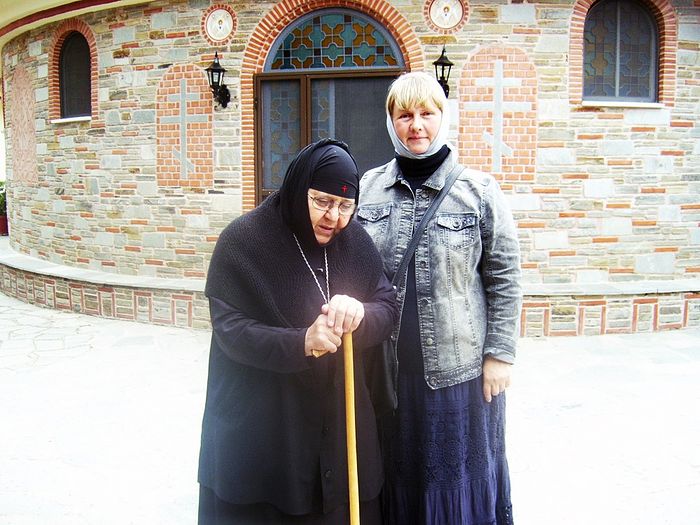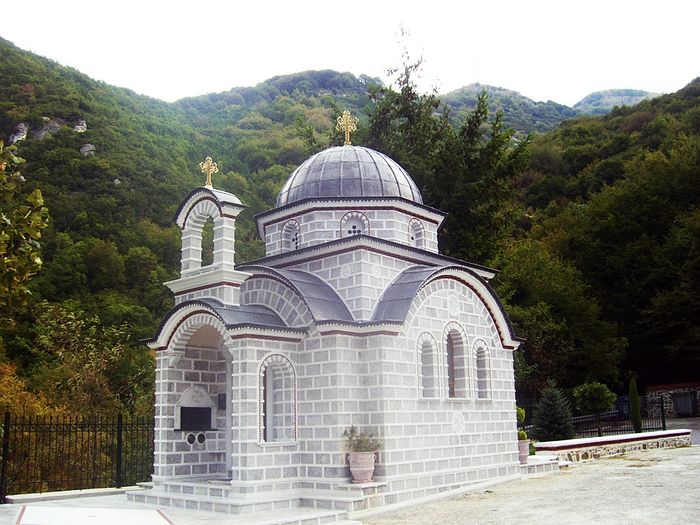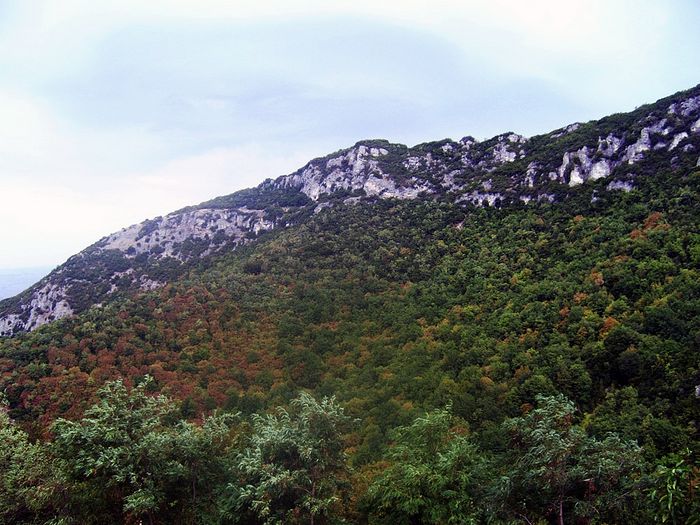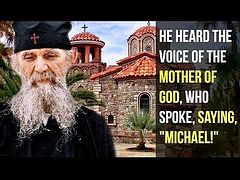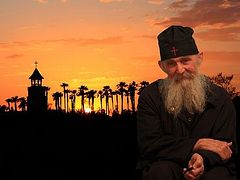Holy Ascension Monastery
Early morning, early September. KTEL Macedonia Bus Station—the main transport hub of Thessaloniki and all of Macedonia—spacious, comfortable. From here, you can go to almost any city in Greece and get to the ferries to the island of Crete, Corfu, Zakynthos, and others. It’s a weekday, and there are few people at the bus station. Only four people board the next bus to the mountain village of Proti Serron. I’m heading for the Holy Ascension Convent. My fellow passengers get off along the way, and I’m the only passenger going all the way to Proti Serron.
Russians rarely come to these parts. Looking ahead, I’ll say that throughout my entire time in Proti Serron and in the monastery, I didn’t hear Russian once, but many Greeks speak English fairly well. Plus, I’ve learned a little Greek, and I could communicate with those who didn’t know English in my few words of Greek. But the locals are so pleased that a foreigner wants to speak in their foreign tongue that they forgive my small vocabulary and communication is quite successful.
Gerondissa Anisia (Emanuelidou), a spiritual child of Elder Ephraim, kindly agreed to introduce me to her monastery and its inhabitants. With her blessing, the monastery secretary Sister Gregoria wrote me a letter, then sent an invitation, and here I am.
On the Greeks’ love for Russians
I want to take a nap on the bus, but my eyes won’t close the entire 2.5-hour drive—there are such interesting surroundings! Finally, the road starts to wind and become steeper, meaning my stop is soon. The mountain village of Proti Serron is small and cozy, with beautiful houses and flowers everywhere. The driver wishes me a safe journey, and I’m left alone. The monastery is located four miles from the village, but all of these miles are uphill, reaching a height of .6 miles.
There’s only one taxi for the entire village, and the young driver, Yannis, valiantly rushes me to the monastery. My heart barely has time to stop on the sharp turns over the precipice. Having found out that I’m Russian, Yannis gives me a considerable discount, declaring that he really loves Russians and Putin. By the way, I later heard from many Greeks about their love for Russians and for our president. Yannis widely smiles and asks me:
“What do you think—why is your president so cool?! And a believer?!”
“Why?”
“Because his great grandmother was a Greek!”
I don’t know about Putin’s great grandmother, but it’s nice when your people and your president are loved.
Monastery in the mountains
The car slammed to a stop at the entrance to the monastery, and again I was alone. The monastery is located between cliffs: On the right—mountains, on the left—mountains. There’s a beautiful view of the village from above. The slopes are quite steep. There are no sharp peeks or ridges, but the high and dense thickets of prickly bushes make these mountains impassable for humans. Down below, in the village, it was about 86°, but there’s such a strong wind here that I have to get my coat out of my backpack.
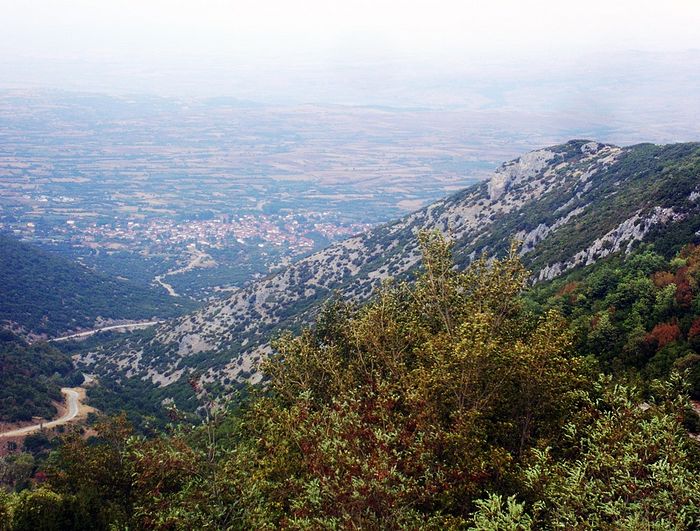 View of Proti Serron from the monastery
View of Proti Serron from the monastery
I didn’t take my coat off the entire week I spent in the monastery. Sharp winds blew, letting up only for a few hours, and then returning with renewed strength, whistling plaintively, and even growling grimly at night, disturbing the short monastic sleep.
I look around. It doesn’t seem like we’re that high up, but the village is far below. The houses look like toys from here. According to the locals, there are no bears in these mountains, but there are wolves, hares, and foxes. There’s a multitude of reptiles: lizards, snakes. They can easily endure the heat and the lack of moisture in the summer months. In the dark, night birds scream shrilly, and during the day you can see vultures and mountain grouses, and occasionally an eagle.
The monastery’s churches and shrines
Holy Ascension Monastery is an ancient and prayerful place, and it shows. It was founded as a men’s monastery in the eighteenth century, but it was destroyed. The Bulgarians not only destroyed the monastery, but also killed the monks. Since then, the monastery was in desolation for many years. In 1979, two nuns came to the ruins of the former monastery. But we’ll say more about that later.
In the meantime, I’m standing in front of the monastery gates. Nearby is the paraklis (small chapel) of the holy Martyr Anisia of Thessaloniki, the protectress of the abbess of the monastery. Across from it is the Church of Venerable Joseph the Hesychast,1 the spiritual father of many Athonite ascetics, including Elder Ephraim of Arizona himself (that’s why many spiritual children of Elder Ephraim call Venerable Joseph the Hesychast their spiritual “grandpa.”).
There’s no one at the gates. I go inside; the sisters are working at their obediences, and besides me, there are no pilgrims on this weekday. I go to the bookstore and finally meet one of the sisters. Her name is Philothea and her obedience is hospitality. Sister Philothea invites me to the guest house, treats me to the traditional coffee and loukoumi, goes for a blessing from Gerondissa, and then accompanies me to the pilgrim’s cell, with a window looking out at the mountains.
Later I find out that there are three other churches here: the main church—of the Ascension, with a wonderworking icon of the Ascension of the Lord, and the Churches of the Archangel Michael and the Annunciation.
I also learn that when the sisters were restoring the monastery premises, they even had to dig, and they got down to the walls the brothers had once built. The stones were hand-hewn, that is, the fathers had to use some antediluvian means to cut the stones in the cliffs, cut them out somewhere in stone quarries, carry them to the monastery and build a residence out of them. When the sisters saw these walls, they were sorry to hide them under plaster from human eyes, and they decided to leave them: Let people see how the fathers labored here. There are also portraits of the fathers that have come down to our times.
Among the monastery’s sacred treasures are numerous fragments of the relics of saints, including relics of St. John Chrysostom and St. Arsenios of Cappadocia.
Services and meals
Services in the monastery are often held at night. Gerondissa comes to the church first and leaves last. She reads the Six Psalms herself. She is seventy-eight years old, and fifty-seven of those years she has spent laboring in the monastery. Even when there aren’t night services, the nuns have little sleep. They wake up at 4:00 AM. The morning services begin at 4:30, when it’s still completely dark and the monastery is illuminated only by the light of streetlamps. The church is full on Sundays: Spiritual children of the Eldress from Kavala, Serres, and all around come to the monastery.
I was used to seeing comparisons of short Greeks with tall Russians in fiction stories, but I was surprised when the men’s half of the church was filled with Greeks of various ages and complexions, but all of them about 6.5 feet tall. And some Georgian pilgrims with a priest arrived on a large bus.
After the morning service, at 6:00, Gerondissa distributes prosphora, and the sisters pray in their cells and rest a little until 8:00, except for those who work in the trapeza, the guest house, and at a few other obediences that require a constant presence. At 8:00, they drink a small cup of coffee, the first meal is at 2:00 PM, and the second meal, more meager, is after the evening service.
The sisters eat very modestly. The food is mostly fasting. Throughout my week at the monastery, there was fish on the table only one time. On the feast they gave dairy products—Greek yogurt—and the rest of the time, fried potatoes, rice, vegetables, olives, potato pies, vegetable filling. As in other Greek monasteries, the sisters begin to eat at the ringing of the abbess’ bell, the second bell signifies that you can pour yourself some cold water from the jug, and the third bell means the meal is over, and the sisters get up and pray. During trapeza, as in all monasteries, they read the holy fathers.
Wind in your face
After dinner we went out into the monastery yard—the wind beat us in the face. The same wind that refreshed me with a light breeze and caressed my sweating brow at the foot of the mountain, here, on the mountain, overturned large, heavy flower pots and tore up the shutters, and I couldn’t help but think that if such strong winds blow here in early September, how they must rage in winter!
And this wasn’t just a natural phenomenon, but also some kind of symbol, a prototype of the spiritual life: The higher you go, the more difficult it is. What makes the sisters of the monastery—these weak, fragile women—labor here, in the mountains, limit themselves in food, cut down on sleep hours, deprive themselves of freedom of movement, travel, and entertainment, and to give up on their own will? The love of God.
Pilgrimage to the monastery
Many people come to the monastery. When pilgrims first came to this monastery, there were no provisions for them. The sisters prayed: “Lord, send us at least twenty chairs and ten beds.” The Lord did not immediately give them what they asked for—He taught them patience. But now the monastery has many chairs, and not simple ones like the sisters asked for, but beautiful chairs, lovingly hand-carved from wood. And 100 people can spend the night in the monastery at the same time.
In obedience to the Church
Across from the trapeza is the grave of Metropolitan Spyridon (Kivetos). He was friends with Geronda Ephraim. When he got sick with cancer, he was sent into retirement. He came here, to this monastery, asking to be received to finish his earthly journey here. Abbess Anisia consulted with Geronda Ephraim, and he answered: “Of course! It is a blessing from God for you!”
And His Eminence departed to the Lord in this monastery. His gravestone reads: “All my life I was in obedience to the Church.” These are his own words, which he said not long before his death. The dates 1973-2003 are also embossed on his tombstone, but they’re not the years of Metropolitan Spyridon’s life, but the years of his archpastoral ministry.
The sisters recall that it was like Pascha at the hierarch’s funeral…
The Eldress’ instructions
All of Elder Ephraim’s gerondissas are different. You can’t get any words out of some of them: They prefer prayer to words. And each has her own spiritual gifts. Gerondissa Anisia has the gift of words, the gift of preaching. She has many spiritual children. She once dreamed of seclusion, hesychasm, but Geronda Ephraim blessed her to receive everyone who would turn to her for spiritual help. People come by the busloads to hear her instructions. She speaks with the sisters every day for their spiritual benefit.
After the evening service and dinner, the nuns traditionally gather in the hall, and Gerondissa Anisia reads passages from spiritual books to them, explains the Psalms, and gives examples from life. During this time, the nuns knit and tie prayer ropes and embroider, but they listen attentively, asking questions.
New sisters come to the monastery every year—that’s a very good sign for a monastery. Three sisters came last year. Next to the abbess sits the oldest nun, ninety years old. About half of the nuns are young, and the other half are middle-aged and elderly.
Next to me is the young Sister Alexia, whisperingly translating the Eldress’ story from Greek to English for me, with Gerondissa Anisia’s blessing. She smilingly shows me a Greek-English dictionary: She is responsible about her obediences and she brought a dictionary with her in case she forgets the translation of any word.
Gerondissa is telling a story about a young man, a resident of the village of Proti Serron. The sisters who came to the monastery from the same village immediately recall that in his childhood and youth he was a very exemplary young man. Then he got carried away with Eastern religions, Hindu practices. He left Orthodoxy, then his passions took hold of him, and he started behaving indecently and started taking drugs. The Lord did not let him perish, and one day he went up the mountain to the monastery and asked Gerondissa for help.
By the prayers of the Eldress and the sisters of the monastery, the young man got better. Gradually, step by step, he changed his attitude to life. He started confessing and communing and even decided to go to Mt. Athos, but Gerondissa didn’t bless him because he was still very weak spiritually.
Gerondissa also talks about her own brother. The sisters know that he has cancer, and Mother instructs him in patience and faith. She teaches her spiritual children to have patience in life, not to ask the Lord to remove their crosses, but that He would grant them patience to bear this cross without murmuring.
Gerondissa mentions a flood on one of the Greek islands. She says that when the cup of human sins overflows, floods and earthquakes occur. The people entreat: “Lord, stop this calamity!” And the Lord answers: “People, stop sinning!”
Gerondissa also reads passages from the Patericon to the sisters—the story of the podvigs of one ascetic in the desert. He endured the heat of the day and the cold of night, hunger, and a lack of drinking water. Exhausted from severe trials, he decided to go to a cenobitic monastery. But when the hermit arrived at the monastery, the brothers started to show him signs of respect as an ascetic who labored for many years in the desert. Then he felt thoughts of vanity and pride approaching his heart, and he decided to return to his desert, because the battle with pride and vanity is heavier than physical podvigs.
You can learn to fast, to endure cold and heat, but acquiring humility is the highest of podvigs.
The next day, Gerondissa kindly agreed to a conversation for the readers of Pravoslavie.ru.
—Dear Gerondissa, could you tell us about how you became a nun?
—I’ve wanted to be a nun since I was a child. Why? How can you answer that? Out of love for God. But my parents wanted me to grow up a little. I arrived at the monastery on January 3, 1959. I was twenty-one.
My first monastery was Holy Ascension in Macedonia. I lived there a little more than a year. The spirit of hesychasm reigned in the monastery: The sisters were not allowed to speak with one another at all, except, of course, for a few brief words for their obediences. Communication with non-monastics was completely forbidden. The sisters, thirty-three of them, were engaged in noetic prayer.
By God’s providence, a year later I moved to another monastery—Holy Dormition in Thessaloniki. I lived there for more than eighteen years.
—And how did you end up in your current monastery?
—In 1979, Geronda Ephraim of Philotheou (and Arizona), a spiritual child of Venerable Joseph the Hesychast, came to visit us. He spoke with the sisters, instructing them.
In those years, there were many ruined monasteries in Greece. Geronda Ephraim, then abbot of Philotheou Monastery on Holy Mount Athos, selected spiritually experienced sisters and sent them to restore these monasteries, to revive monastic life there. I can’t call myself spiritually experienced, but by that time I had twenty years of experience of the monastic life behind me, and I dreamed of a secluded monastery, where I could pray without distraction.
Geronda Ephraim talked about our monastery, which lay in ruins then, with Bishop Spyridon (the future Metropolitan), and he blessed us to find sisters who would dare to restore it. Then Geronda brought me and one other sister, Markella, here, to these mountains.
—What did it look like in those years?
—Geronda Ephraim showed us the ruins of a once-large, strong men’s monastery, where the brethren prayed for more than 200 years before the monastery was destroyed by the Bulgarians who were claiming the territory of Greek Macedonia. They slaughtered all the fathers and destroyed the buildings. No one else settled there. Only wolves and snakes lived in the ruins.
We sat on the rocks—on the ruins of the monastery. All around were mountains covered with forests. There were no buildings to live in. The strongest winds, wolves howling. On the spot of this guest house, where we are now sitting, was a ruined stable. There was nothing!
There were absolutely none of the amenities that modern people are used to. The fathers carried everything up the mountain on their own shoulders. In order to get something, even firewood, you had to go down the mountain, to the village, and not only did we not have any cars, but we didn’t even have a donkey! And now, you can drive from the village to the monastery in half an hour along paved roads; but then—on foot, without a road, and up a mountain…
And I thought: You wanted isolation—there’s plenty of it here! A true place for hesychasts.
—And you decided to stay here?
—Sister Markella told me then: “We can’t live here. There isn’t even a roof over our heads! There’re just wolves howling… They’ll eat us!” I thought: “Two weak women… How will we be able to restore even one house? There’s nowhere to live, nowhere to pray…” We left.
A month later, my heart told me: “Go look again…”
The sister and I went again. We looked. No, it’s impossible for us to stay here… We left again.
Two months passed. My heart said again: “You have to go there again…”
And the sister and I went a third time. There was a spring, a fountain, and an icon over it. We sat down on the rocks and I started praying. I said the Jesus Prayer and suddenly I felt such grace! I heard in my heart: “We have to stay here!”
I said to Sister Markella: “We’re staying! This is Heaven! This is a place of prayer. The fathers prayed and labored here. It’s a very suitable place for the Jesus Prayer.”
She objected: “If we stay here, the wolves will eat us!” I answered her: “If Christ allows the wolves to eat us, let them eat us!”
So we stayed.
—How did the building of the monastery go?
—Bishop Spyridon helped us restore everything. The first years were very hard. We lived in tents. First we restored the church so the Liturgy could be served. That was the main thing.
Geronda Ephraim would come for two to three days three times a year—and all the difficulties were miraculously resolved. Geronda Ephraim has very strong prayer. When he came, we felt great comfort and spiritual joy. I asked Geronda for a quiet, secluded place; but not as I want, but as the Lord wants…
I wanted us to have three or four sisters here, but they multiplied and the monastery grew. And it was the will of God.
Geronda Ephraim told me: “You will have a monastery that people will come to. Show them all hospitality. Welcome everyone.”
Things worked out for me like with Elder Silouan the Athonite: He sought solitude, but the Lord sent people to him. Now we have twenty-five sisters. They do needlework, iconography, they collect medicinal herbs, they make ointments, tinctures.
Geronda Ephraim can no longer come to us; now we go to him in Arizona every year.2 We are pastored by Archimandrite Philotheos, the abbot of Karakallou Monastery on Holy Mount Athos, one of the first spiritual children of Geronda Ephraim.
Three years ago we had a vision (I can’t describe it in detail, I’ll just say it briefly), that Venerable Joseph the Hesychast was covering our monastery with his prayer. His presence is felt everywhere here.
—You even have a church dedicated to Venerable Joseph the Hesychast.
—Yes, and there’s an amazing story connected with the construction of this church.
—Could you tell us about it?
—We decided to build this church very small and modest, to resemble the church on the Holy Mountain where Venerable Joseph the Hesychast labored. We took a blessing from the bishop and from Geronda Ephraim, we consecrated the site, and we began to lay the foundation.
On the very first day of work, Elder Joseph the Hesychast appeared to the foreman, just as he is depicted in the photo with a staff in his hand. The Elder looked around at everything, tapped with his staff, and said: “It’s going to be a little too small. I can’t fit.”
The foreman ran to me and shouted: “The Elder is displeased! We have to build a bigger church!”
We were getting ready to go to Arizona to show Geronda Ephraim the design for the new church. The design was redone. I looked at it and got upset: Instead of the originally conceived ascetic, small church, it turned out be a larger church. Of course, it was still very small, but now there were domes and marble in the design. I went to my cell upset, and the foreman went to work.
And Elder Joseph appeared to him again. He looked all around and was satisfied. He told the foreman he liked everything. The foreman again ran to me and we decided to leave the domes and marble in the design. I said: “May it be blessed.”
We also asked Grandpa Joseph: “O Venerable one, if you want the church to be a bit bigger, you have to give us the money with which to build it.”
And the church started to build itself! Elder Joseph sent people to us, and in the exact order that was necessary for the construction of the church!
When the walls were erected, the money ran out. We turned to Elder Joseph for his prayerful help, and a man immediately came to us who had inherited a marble business from his father. He asked: “How can I help you? I have marble.” This man did everything, and he still had marble left over, so he finished the sisters’ building with marble.
(Here it should be noted that there are quarries everywhere in Greece where marble is extracted. It is considered an inexpensive finishing material in their construction.)
We needed an iconostasis, and a man appeared who made one. We didn’t build the church—Venerable Joseph the Hesychast built it himself.
—It’s simply a miracle!
—Sometimes miraculous things really do happen here in the mountains. One pilgrim heard the service going on, heard the bells ringing. She went to the church certain that Liturgy was being served, but the church was empty.
We didn’t attach any importance to this story, but then something similar happened again. One time some pilgrims came here, saw these deserted mountains, and marveled: “How could you like this place?!” Then they heard Vespers, although there was no service at that time.
One day my mother was downstairs and heard chanting and prayers. She thought she was hearing us, nuns, and was certain we were praying and singing. When she went upstairs, she asked: “Was that you singing just now?” “No, we’re working and praying silently.” “But I heard chanting!” my mother insisted.
And we really were working silently and saying the Jesus Prayer to ourselves…
Many things happen here, but we don’t especially publicize such cases, so there wouldn’t be too many pilgrims. The holy fathers say: “A man who has been vouchsafed to see his own sins is higher than he who has been vouchsafed to see angels.”
—Thank you, dear Gerondissa, for a wonderful conversation!
—God bless you!
How important it is to obey the Eldress
I’m planning to leave the monastery on Saturday. The days are all planned out because I’m supposed to stay in another monastery, on the island of Thasos, where Geronda Ephraim’s mother, Nun Theophano, is buried. To my surprise, Gerondissa Anisia urges me to stay and go on my way on Sunday. I, of course, render obedience to the Eldress.
As it turned out later, had I left on Saturday, I wouldn’t have made it to the monastery on Thasos: A fire was raging near the monastery, the roads were blocked, and the sisters and pilgrims were evacuated. On Sunday, the threat of fire for the monastery passed—just some buildings and the olive garden suffered damage. And I made it to the monastery in peace.
Moreover, the Eldress’ spiritual children, the couple Elena and Yannis with their sons Alexander and Anthony, gave me a ride. They live in Kavala, but they went further for my sake, to the port of Keramoti, where Yannis accompanied me to the ferry to the island of Thasos.
They also told me about their Eldress.
A conversation with Gerondissa’s spiritual children Yannis and Elena
—Thank you for agreeing to give me a ride.
Elena: Gerondissa blessed us to help you. We’ve been going to this monastery for a long time, but you’re the first Russian we’ve seen here.
—Do you visit the monastery often?
Yannis: We come to Liturgy every Sunday. After the service, Gerondissa usually gives some instructions in the guest house. And it’s amazing: Before going to the monastery, I think of questions I want to ask Mother, but I hear the answers to my questions in her instructions before I can even ask them.
—Mother is an eldress…
Yannis: Yes. She speaks with God, and God speaks with her. Mother prays for all of us. Every night she stands in prayer. The sisters told me one time that Gerondissa commemorates about 8,000 people by name every night. Every night!
—When does the Eldress sleep?
Elena: When God is in your soul, you don’t want to sleep, like us ordinary people.
Yannis: The sisters divide the day into three parts: work, prayer, rest. They all sleep little, but Gerondissa less than all. She sleeps about four hours a day, maybe four and a half.
—Gerondissa blessed me to leave not on Saturday, but on Sunday. I don’t think this was by chance...
Yannis: Of course! She is clairvoyant. When Gerondissa prays, she sees the hearts of everyone she prays for. I had some problems one time. I told her: “Gerondissa, I have some problems,” and she immediately understood all of my difficulties and gave me advice and answered all my unspoken questions.
Elena: Gerondissa sees things but doesn’t speak about them. She hides her gifts. You can guess at them from indirect signs. Sometimes she can forget herself and ask about some detail, such as the illness of a child, grandchild, or a relative; or about some kind of problem. And only then do you realize that you didn’t tell the Eldress about it—she learned about it herself.
Yannis: But the main miracle is that two weak women, Gerondissa Anisia and Mother Markella, came here, to this desolate place, to these deserted mountains, to the ruins of this ancient monastery, and, with God’s help, built such a large, wonderful monastery, with beautiful churches, with many sisters…
—Yes, it’s a real miracle.
Through the prayers of our holy fathers, Lord Jesus Christ our God, have mercy upon us!

